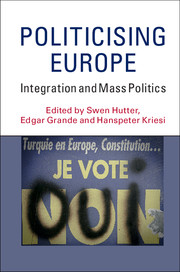Book contents
- Frontmatter
- Contents
- List of figures
- List of tables
- List of contributors
- Preface and acknowledgements
- Part I Theory and methods
- Part II Mapping the politicisation of European integration
- Part III Driving forces and consequences of politicisation
- 6 Constitutive issues as driving forces of politicisation?
- 7 The radical right as driving force in the electoral arena?
- 8 Framing Europe: are cultural-identitarian frames driving politicisation?
- 9 Politicisation, conflicts and the structuring of the EU political space
- 10 The euro crisis: a boost to the politicisation of European integration?
- Part IV Conclusions
- Methodological Appendix: measuring politicisation, benchmarks and data
- Bibliography
- Index
7 - The radical right as driving force in the electoral arena?
from Part III - Driving forces and consequences of politicisation
Published online by Cambridge University Press: 05 March 2016
- Frontmatter
- Contents
- List of figures
- List of tables
- List of contributors
- Preface and acknowledgements
- Part I Theory and methods
- Part II Mapping the politicisation of European integration
- Part III Driving forces and consequences of politicisation
- 6 Constitutive issues as driving forces of politicisation?
- 7 The radical right as driving force in the electoral arena?
- 8 Framing Europe: are cultural-identitarian frames driving politicisation?
- 9 Politicisation, conflicts and the structuring of the EU political space
- 10 The euro crisis: a boost to the politicisation of European integration?
- Part IV Conclusions
- Methodological Appendix: measuring politicisation, benchmarks and data
- Bibliography
- Index
Summary
Introduction
In Chapter 4, we presented an overall map of the levels of politicisation in the electoral arenas of the six countries covered by this book. We demonstrated that European integration has become a relevant factor in national elections and that a general trend towards higher levels of politicisation in the post-Maastricht era exists. However, Chapter 4 also pointed to remarkable across- and within-country differences that could not be sufficiently explained by the questions at stake and the political context. More generally, we concluded that integration problems do not automatically lead to manifest political conflict and thus to politicisation in election campaigns. They rather produce potentials for political mobilisation, and these potentials have to be exploited by political actors.
The present chapter builds on these results and focuses on political parties, the key players in the electoral arena and the main non-governmental actors in integration debates more generally (see Chapter 3). In other words, we analyse the factors which influence parties’ decisions to strategically use European issues, and we explore how parties position themselves towards them. It is these strategic decisions that may finally explain the level of politicisation in the electoral arena. Our data again cover the sixty-one national elections from 1970 to 2010. Besides variation in selective emphasis and position taking, which we examine in this chapter, party strategies also differ, as discussed in Chapter 1, with respect to justification framing. This aspect, however, will be dealt with in the subsequent Chapter 8.
In the introductory chapter, it was argued that radical right and Eurosceptic parties may form the most important driving forces of the politicisation of Europe (radical right hypothesis). In contemporary politics, populist radical right parties seem to stand out as the most Eurosceptic party family. They oppose the pro-European mainstream, their (relative) visibility in election campaigns is high when it comes to the articulation of European issues and they also focus on constitutive aspects, which – as Chapter 6 has demonstrated – are the most conflict-prone. Many authors (e.g. Kriesi 2007; Kriesi et al. 2008; Hooghe and Marks 2009; Kriesi et al. 2012) therefore see these parties as the driving force of politicisation of Europe in the electoral arena. When comparing different routes towards politicisation in this arena we will call a path shaped by this party family a Type 1: radical right path.
- Type
- Chapter
- Information
- Politicising EuropeIntegration and Mass Politics, pp. 156 - 180Publisher: Cambridge University PressPrint publication year: 2016
- 22
- Cited by

